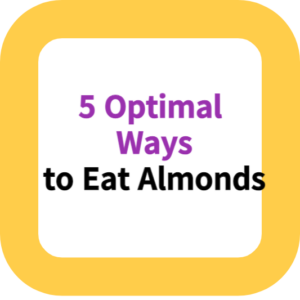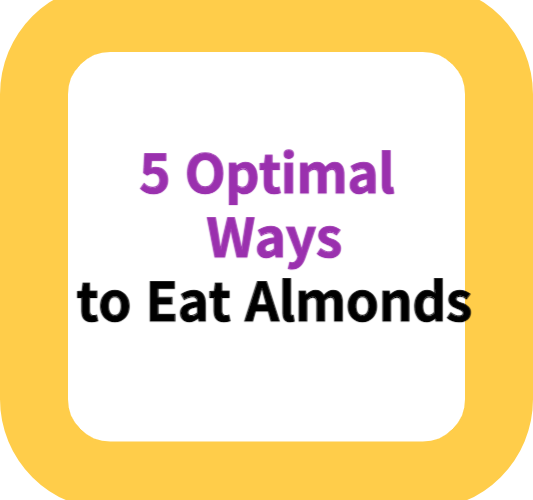5 Optimal Ways to Eat Almonds
Welcome to our blog, where we’re excited to share the incredible versatility and health benefits of almonds, a true gem in the culinary world. Almonds aren’t just a healthy snack; they’re a powerhouse of nutrition and a cornerstone in creative cooking.
In this space, we delve into the myriad ways almonds can enhance your meals, from adding a crunchy twist to fresh fruits to revolutionizing your baking repertoire.
Our journey will take you through innovative recipes, nutritional insights, and culinary tips that highlight almonds in all their glory. Whether you’re a seasoned chef or a curious food enthusiast, our blog promises to offer something delightful and insightful for everyone.
As we explore the multifaceted world of almonds, we’ll show you how this humble nut can transform your everyday cooking. From simple additions that elevate fruit dishes to gourmet creations that impress, almonds are incredibly adaptable and nutritious.
We’ll share recipes like the Strawberry Coconut Almond Coffee Cake and the savory Zesty Tomato Smoothie, demonstrating how almonds can be incorporated into various meals. Plus, we’ll provide tips on how to use almond butter and create dairy-free almond-based cheeses, expanding your culinary palette. Join us on this almond-filled adventure, where health meets taste, and discover the endless possibilities that almonds have to offer in your daily cooking.
5 Optimal Ways to Eat Almonds

Introduction: The Multifaceted Nutritional Benefits of Almonds
Almonds stand out as a nutritional powerhouse in the world of nuts. Whether enjoyed raw, roasted, or in more innovative forms, almonds offer a range of health benefits.
Particularly noteworthy is the practice of soaking and peeling almonds to enhance nutrient absorption, as the skin contains tannins which can hinder this process. This versatile nut can be a pivotal component of a healthy diet, adaptable to various culinary uses.
1. Almonds in Fresh and Cooked Fruit Dishes
A simple sprinkle of almonds can transform ordinary fruit dishes into extraordinary culinary delights. Whether it’s a vibrant fruit salad, a warm baked grapefruit, or a comforting fruit cobbler, almonds add a crunchy texture and a nutty flavor.
A standout recipe to try is Sautéed Figs with Cinnamon and Almonds – a harmonious blend of fresh figs, fragrant cinnamon, and crunchy almonds, perfect as a standalone dessert or as a topping for breakfast dishes.
2. Incorporating Almonds into Baking
Almonds bring a unique texture and nutty flavor to baked goods, elevating them from ordinary to exceptional. They can be integrated into various recipes, from fluffy coffee cakes and chewy bars to crumbly cookies.

For instance, the Strawberry Coconut Almond Coffee Cake is a delightful treat, combining the sweetness of strawberries with the richness of almonds. Similarly, the Lavender Almond Cookies offer a delicate, floral note, making them an exquisite pairing with a cup of English tea.
3. Adding Almonds to Smoothies for Nutritional Boost
Almonds can significantly enhance the nutritional profile of smoothies. When blended with fruits and vegetables, they add a boost of protein and healthy fats without overpowering the smoothie’s natural flavors.
They can be incorporated as whole nuts, almond butter, or almond milk, offering versatility in both sweet and savory recipes. A notable example is the Zesty Tomato Smoothie, a savory blend that creatively includes almonds for added depth and nutrition.
4. The Versatile World of Almond Butter
Almond butter is a creamy, delicious alternative to traditional nut butters, and its versatility knows no bounds. It can be spread on toast, sandwiches, and fruits, or used as a healthy fat replacement in baking. Additionally, almond butter serves as an excellent dip for vegetables and fruits or as a rich, nutty topping for cereal and smoothie bowls, demonstrating its wide range of culinary applications.
5. Creative Uses of Almonds in Dips and Creams
Almonds have a special place in the realm of vegan culinary arts, especially when used in creamy dips or sauces. They add a rich, plant-based element to a variety of dishes, from savory lentil patties to baked potatoes. The Almond Sage Cranberry Crema is a quick, flavorful dip that can be customized with different herbs and spices.
Furthermore, almonds can be transformed into dairy-free cheese alternatives, such as soft cheese or ricotta, and even ground to mimic cotija or parmesan, expanding their culinary versatility.
Conclusion: Embracing Almonds in Everyday Cooking
Almonds are not just a snack but a versatile ingredient that can enhance a wide array of dishes. From adding crunch to fruit dishes and baked goods to enriching smoothies and creating innovative dips and creams, almonds offer both nutritional benefits and culinary diversity.
They are an essential ingredient for those seeking a balanced, plant-based diet. For more creative ideas on how to incorporate almonds into your meals, explore recipes in the “California Vegan” cookbook, showcasing the versatility and health benefits of this remarkable nut.
